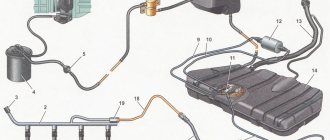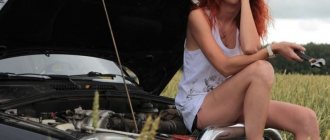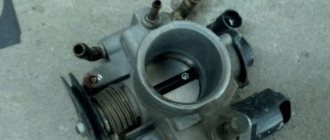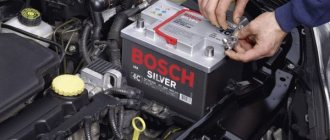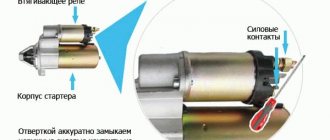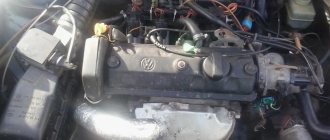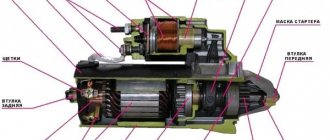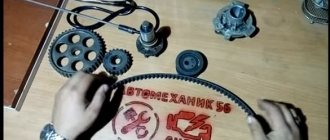Starting an engine is a serious task, the competent solution of which requires compliance with a lot of conditions. Ideally, the starter should start the engine a couple of seconds after turning the key, but in practice it is often different. Sometimes starting the engine can take several tens of seconds and does not occur after the first turn of the key. If you have to turn the starter for a long time to start the engine, there may be several reasons for this. It is important to identify the malfunction and eliminate it, otherwise it is fraught with serious consequences.
What to do if your VAZ-2110 (8-valve injector) doesn’t start well: reasons
There are many reasons why the fuel-injected VAZ-2110 with 8 valves does not start well after an overnight stay.
A particularly common situation is when everything was fine in the evening, and in the morning an unpleasant surprise is discovered in the form of a non-working car. Next, we will consider what reasons can lead to difficulties in starting the injection VAZ-2110 and what to do to fix the problem. To determine why a car has trouble starting, you need to know how it works. A spark is responsible for starting the engine, which, in turn, is completely dependent on the ignition system and the fuel-air mixture, supplied in precisely metered proportions. If one component of this chain is broken, starting is problematic or completely impossible.
How to start easier in cold winter
Advice! To make starting the engine in the cold season much easier, we recommend installing an auto-start alarm on your car.
Warming up every certain time. Fuel consumption will suffer, but the likelihood of starting in severe frost will increase
If the temperature drops below 20 degrees minus, you can set the engine to automatically start every three hours. This will not only allow you to get into a warm car in winter, but will also prevent the oil from thickening too much during severe night frosts, which will certainly have a beneficial effect on the condition of the engine as a whole.
Common breakdowns
Sometimes there is a situation when the starter turns, the click is clearly audible, but at the same time the spark plugs flood, and replacing them with new ones leads to repeated flooding.
Regular cleaning of the spark plugs will help. If you encounter such a problem, then in order to start the car, you need to check the injectors; perhaps they are clogged, and this was the main reason for the spark plugs to flood. Also, the fuel pump may not create pressure acceptable for vehicle operation. Additionally, it is necessary to check the mass air flow sensor. The sensor may be feeding incorrect information, causing more fuel to enter the engine. Repairing or replacing the sensor will help fix the problem.
The car starts on the second try. Most likely, the throttle valve or DHW is clogged. To eliminate the problem, you need to flush the devices.
It is impossible to start the car in winter, although the starter turns normally. When faced with this situation, it is necessary to unscrew the spark plugs and crank the starter to free the engine from fuel. Heat a new set of spark plugs, and while they are warm, screw them into the engine block. Start the engine.
The engine does not start well, and a light with an exclamation mark appears on the dashboard, after which it stalls. A lamp with this designation indicates that voltage is still supplied to the starter, although the engine has started. Most likely, the engine did not decouple and the starter broke down. To eliminate the problem, you need to replace the starter.
If you find an error, please select a piece of text and press Ctrl+Enter.
Source
Messages 15
1 Topic by vam_sam 2017-04-28 00:52:36 (2017-04-28 00:56:31 edited by vam_sam)
- vam_sam
- New member
- Inactive
- Registration: 2015-08-14
- Messages: 22 Thanks : 4
- Car: VAZ 2111
Topic: Very difficult to start, especially when cold, takes a long time to turn (video)
Hello everyone, I’m back with my 21113 16kl, the car still starts up disgustingly. Namely, it doesn’t start right away, but it spins for 4 seconds, after which it farts for 2-3 seconds with vibration in the body and rpm of 850-1000, after which the warm-up starts at 1300, this happens only after a long stay, if the engine is warm, it starts without this, but it also turns for a long time, but for some reason immediately after starting it drops the revolutions to 500, and gets up to 850 immediately after a second. I decided to write because today I decided to blow out the cylinders, in the end it stopped gripping altogether, only if I give it some gas, I’m fundamentally not happy with it. The fuel pump and air flow sensor are working properly, the spark plugs are January, the same thing happened on the old ones. This is a very tough option at -20, it seems like it was in the winter [video], and this is also not what it usually is, but almost imperceptibly [video], something consistently happens between the first and second video. Where to dig? For now, the plan is to try replacing the ignition module and wires, but if you pull the current ones one by one, the engine starts to shake
Reasons for the long start of the 2110 engine
_________________ Cost of operating Priora for 75_000 km: 3 rubles 23 kopecks/km.
They were either left behind or stupid.
injectors are new. I changed all 4 on Saturday.
. or something else.
injectors are new. I changed all 4 on Saturday.
No, the topic was that the voltage in the injector control harness drops, which is why there are problems during startup. At least that's what they said.
It's not the load, but the different settings that the controller uses depending on the engine temperature.
Look at the starter price.
it was so. there was a sad Belarusian GE. This winter I threw it away and installed katek. And in winter the zavodka became excellent, and in summer it does not stall when starting.
Updated. I watched the video.
Dude, why are you raping the motherfucker like that? She needs affection and lubrication. and you use it like a dry rasp.
Have you tried changing the gas station? As an option?
Yes. Pull off the plug from the receiver, which is next to the hose on the RTD.
If the starting is normal, it means your fuel is too much and there is not enough air.
Dude, why are you raping the motherfucker like that? She needs affection and lubrication. and you use it like a dry rasp.
Well, where to go? I need to go.
Have you tried changing the gas station? As an option?
tried it. did not help.
Yes. Pull off the plug from the receiver, which is next to the hose on the RTD.
tried it. did not help.
Check carefully with a DMRV tester for deadness.
The air flow sensor was checked according to the BC. seems normal.
Throw in a new DTOZH.
I'll do it one of these days. I bought the DTOZH, I just need to install it. I'll do it today.
Well, the symptoms seem to be electrical
I don’t know what to sin anymore.
Although there is no definite answer on this topic.. But I didn’t find a very similar topic by searching, but my topic is close, I’ll ask here:
On the effect of contamination of the internal surface of the throttle pipe (DP) on engine operation.
©Ivan Skrydlov aka Aktuator
1. The engine has difficulty returning to idle speed when the gas pedal is released. For example, when braking or coasting in neutral gear. The engine speed, instead of a smooth return to XX speed, suddenly drops sharply to 400-600 revolutions, after which the engine stalls or shakes violently, and XX speed is difficult to restore.
2. Hot starting of the engine is very difficult, and if measures are not taken in a timely manner, cold starting. When trying to start the engine, you have to turn the starter for a long time. The exhaust pipe already smells of gasoline, but the engine still won’t start. But as soon as you open the remote control slightly, by 2-10%, by pressing the gas pedal, a miracle happens, the engine starts, “wasting” the first few seconds.
The cause of the above malfunctions is a mixture of dust microparticles and oil particles passing through the air filter, coming from the crankcase ventilation system. During vehicle operation, this mixture gradually settles on the inner surface of the diesel engine, in those places where there is the greatest air turbulence. Those. immediately behind the remote control and on the IAC rod. As a result, over time, the thermal gap at the DZ becomes overgrown with dirt and the cross-section of the IAC bypass channel decreases.
Thus, as a result, we get the following: the cross-section of the air channels is reduced, the composition of the mixture is enriched.
When dirt accumulates above a certain critical level, different for each engine, when the speed control system can no longer cope with the flow area in the combustion chamber that has changed due to dirt (which it also knows nothing about), characteristic interruptions begin to appear.
Throttle pipes operating in systems controlled by GM controllers are much less susceptible to loss of functionality in the presence of dirt. In them, gases from the crankcase ventilation system are supplied to the throttle space.
It should be noted that on 1.6-liter engines, due to changes in the channels of the crankcase ventilation system, several times more oil vapor began to enter the combustion chamber. What exactly and how it has been changed is not discussed in this article.
For reference: With a hole diameter of 10 mm and a distance from the IAC rod to the walls of the hole of 2 mm, we have a ring for air passage, with an outer radius of 5 mm and an inner radius of 3 mm. Ring area = pR1²- pR2² = 3.14*5²-3.14*3²= 50.27mm². If there is a layer of dirt 0.25 mm thick, all other things being equal, we have the ring area = 3.14*5²-3.14*3.5²=38.42 mm². The difference is almost 34%. Those. instead of 14.7, the composition of the mixture will become
9.7. This does not take into account the cross-section of the thermal gap.
Will the engine be able to start or operate normally with this mixture composition? The correct answer is no.
How long does it take for such a layer of dirt to build up? For 20-50 thousand kilometers.
From practice, dirt in the DP should be taken into account as one of the possible reasons for the unstable operation of the engine at IH and IH after 10-15 thousand kilometers. Naturally, this value may vary somewhat depending on the areas in which the vehicle is used. In steppe areas, with a lot of dust, it will most likely be less, and in areas of the far north, where there is snow most of the year, it will be more.
At the beginning of 2005, at our enterprise, the operation “Washing the throttle pipe” was introduced into the routine maintenance during scheduled maintenance according to coupon No. 2 (mileage 14,500-15,500 km). Now, by the end of 2006, the cause of unstable XX on warranty vehicles is DP contamination in 1-3 cases per 100 calls, versus 20-30 before. On non-warranty vehicles, everything remained unchanged.
Source
How to eliminate floating idle speed on Lada Largus
One of the shortcomings that was noticed by owners of Lada Largus cars is floating speed after starting the engine in the morning. A long search for the cause of the unstable operation of the power unit led to the throttle assembly. It turns out that the whole problem lies in air leaks through the connections of the intake receiver and the remote control.
To troubleshoot the problem we will need:
- Ratchet heads for 6 and 8
- Torx key T-25
- Neutral sealant (odorless)
- FUM tape with a thickness of 0.075 mm, which is used by plumbers to seal threaded connections.
- Silicone Grease
- Clamp with screw tensioner 22x27 to strengthen the idle air channel hose
Instructions for eliminating floating speed on Lada Largus
- We disconnect and remove the throttle cable stopper from the lever on the throttle assembly.
| There is no gasoline in the tank. | On the instrument panel the fuel level arrow is at zero. | Fill with gasoline. |
| Low battery charge. | A characteristic crackling sound when trying to start. When checking the voltage it shows less than 12V. | Charge the battery. |
| Loose contact of battery terminals or their oxidation. | Crackling sound from under the hood. Low voltage on-board network. | Clean the terminals and fit them onto the battery terminals as tightly as possible. |
| There are no connections between the electrical circuits of the power supply and control systems | Checking the reliability of the connection of the wire blocks. | Connect the connectors tightly. |
| The rotation of the crankshaft is difficult (scuffing of the piston group, liners, deformation of the shaft, jammed water pump, generator). | Slow rotation of the crankshaft, extraneous noise when starting and running the engine. | Replacement of failed parts. |
| Problems with the ignition system. | Netiskra. | Check all elements and parts of the ignition system, replace if necessary. |
| High voltage wires are installed out of order or disconnected. | Inspection. | Install in the correct sequence and replace if necessary. |
| Broken or worn timing belt. | Visual inspection. | Replacing the timing belt. |
| The valve timing is disrupted. | Inspect the location of the crankshaft and camshaft marks. | Set the phases according to the marks. |
| Malfunctions in the electronic engine control unit (ECU): crankshaft position sensors, coolant temperature sensors, phase sensors. | Find out whether power is supplied to the ECU, whether there is an open circuit, check the serviceability of the sensors. | If necessary, change the software of the control unit or replace the ECU, as well as the sensors. |
| The IAC (idle air regulator) has failed. | Check the IAC (if the engine starts only with the gas pedal pressed, and stalls when it is released). | Replace the regulator. |
| Control system fuse or relay has blown. | Checking the relay and fuse. | After eliminating the cause of the blown fuses, replace them. |
| The fuel pump is faulty, the fuel pump relay fuse has blown. | After turning the ignition key, there is no characteristic sound of the pump in the gas tank when fuel begins to flow into the ramp. Check the fuse, apply voltage directly from the battery. | Replace faulty parts. |
| Fuel filter clogged, water freezing in the fuel line. | Measure the pressure in the fuel system. | Replace the fuel filter and fuel line parts. |
| Low pressure in the fuel rail. | Check the pressure, fuel pump filter and fuel line for damage. | Replace the filter or fuel pump, fuel pressure regulator. |
| Faulty injectors. | Check the functionality of the injectors. | Replace faulty parts. |
| Air in the intake system. | Inspect the intake parts for air leaks, check the vacuum brake booster. | Eliminate air leaks, replace the faulty brake booster. |
Why does the VAZ 2110 injector engine take a long time to start?
There are many reasons why the fuel-injected VAZ-2110 with 8 valves does not start well after being parked overnight.
A particularly common situation is when everything was fine in the evening, and in the morning an unpleasant surprise is discovered in the form of a non-working car. Next, we will consider what reasons can lead to difficulties in starting the injection VAZ-2110 and what to do to fix the problem. To determine why a car has trouble starting, you need to know how it works. A spark is responsible for starting the engine, which, in turn, is completely dependent on the ignition system and the fuel-air mixture, supplied in precisely metered proportions.
If one component of this chain is broken, starting is problematic or completely impossible.
Other differences
The engines also differ in their “inhalation” design. The 120th intake consists of two aluminum parts: a manifold (“horn”) and a receiver, connected to each other by rubber corrugations. Unit 21124 is “decorated” by an intake system made of plastic and consisting of a single part.
The ignition system is designed differently. The VAZ 2112 is equipped with an ignition distributor module, and on the 21124, individual coils are installed for each cylinder. Due to differences in intake and ignition systems, valve covers also differ.
The 1.6-liter unit has some other differences from its brother: the pressure regulator has been moved from the fuel rail to the pump, the catalyst is located directly at the cylinder head, there are 2 oxygen sensors (Euro-3) instead of one (Euro-2) for the 1.5 liter. The split timing case design makes it easy to replace the timing belt.
People often ask: where is the serial number of the engine on the VAZ 2112? Indeed, the number located under the air filter is quite difficult to detect. It is located at the rear end of the BC, under the thermostat housing. To find the required numbers, you need to release the air filter mount and tilt it slightly to the side.
Common breakdowns
Sometimes there is a situation when the starter turns, the click is clearly audible, but at the same time the spark plugs flood, and replacing them with new ones leads to repeated flooding.
Regular cleaning of the spark plugs will help. If you encounter such a problem, then in order to start the car, you need to check the injectors; perhaps they are clogged, and this was the main reason for the spark plugs to flood. Also, the fuel pump may not create pressure acceptable for vehicle operation. Additionally, it is necessary to check the mass air flow sensor. The sensor may be feeding incorrect information, causing more fuel to enter the engine. Repairing or replacing the sensor will help fix the problem.
The car starts on the second try. Most likely, the throttle valve or DHW is clogged. To eliminate the problem, you need to flush the devices.
It is impossible to start the car in winter, although the starter turns normally. When faced with this situation, it is necessary to unscrew the spark plugs and crank the starter to free the engine from fuel. Heat a new set of spark plugs, and while they are warm, screw them into the engine block. Start the engine.
The engine does not start well, and a light with an exclamation mark appears on the dashboard, after which it stalls. A lamp with this designation indicates that voltage is still supplied to the starter, although the engine has started. Most likely, the engine did not decouple and the starter broke down. To eliminate the problem, you need to replace the starter.
Along with high efficiency and relative reliability, fuel-injected cars have one unpleasant drawback - the difficulty of repair. It happens that the injector suddenly stops starting, and it becomes difficult to do anything with it. It’s good if you have the opportunity to call a tow truck or show the car to a professional, but what should those motorists do who are left with the problem alone? Let's figure it out by examining in detail all the reasons why the injector starts poorly or refuses to start at all, as well as how to “treat” such a malfunction.
Carburetor
If there is a problem with it, you must first clean it. With such a task, it is better to turn to specialists - they, in particular, are able to quickly:
- adjust the carburetor;
- clean its dampers;
- check compression.
In severe cases, it is necessary to rinse it completely. However, sometimes the car does not start due to the fact that the bimetallic plate, intended specifically for the cold start of a power plant with a carburetor, has become unusable.
Possible faults
No matter how trivial it may sound, if the injector does not start, it means something has gone wrong. The success and speed of repair depends on how quickly and efficiently the problematic link in the car’s design can be identified. To better understand the essence of repair activities, it would be a good idea to pay attention to potential breakdowns. The basic list of the latter is as follows:
In addition to the breakdowns described above that can break the operation of the injector, the problem may lie in more trivial things. An example of this is a weak battery charge or lack of fuel in the tank. Considering just such incidents, before repairing a car, it is extremely important to exclude the possibility of their occurrence, so as not to waste extra time and nerves.
The procedure for returning the car to “life”
Let's say you find yourself in circumstances where the injection engine starts poorly or refuses to do so at all. There is no need to hesitate in such a situation - it is advisable to immediately begin resuscitation procedures. If you don’t have time to figure out the exact reason why the car doesn’t start well, then you should quickly carry out the following algorithm of actions:
In general, there are no particular difficulties in repairing a non-starting injector. The main thing in the process of such work is to act competently, in accordance with the procedure and possible vehicle malfunctions described above.
Prevention of injector breakdowns
Why the injection engine does not start and how to eliminate possible problems is now known to all readers of our resource. However, it is better to avoid such breakdowns, so let’s pay attention to ordinary procedures that, if carried out systematically, will help minimize the risks of all malfunctions. The simplest but most effective prevention consists of the following measures:
Perhaps this is where the most important information on today’s issue has come to an end. We hope the material presented above was useful and provided answers to your questions. Good luck in operating and maintaining your car!
Starting an engine is a serious task, the competent solution of which requires compliance with a lot of conditions. Ideally, the starter should start the engine a couple of seconds after turning the key, but in practice it is often different. Sometimes starting the engine can take several tens of seconds and does not occur after the first turn of the key. If you have to turn the starter for a long time to start the engine, there may be several reasons for this. It is important to identify the malfunction and eliminate it, otherwise it is fraught with serious consequences.
Mercedes won't start in cold weather
Mercedes Sprinter starts poorly in cold weather
Mercedes Sprinter I (W901,W905) 1995 - 2006
At sub-zero temperatures it is difficult to start. At minus 6, I turned the starter for 30 seconds. We took it to the service center, they shrugged their shoulders, they said everything was fine (only the temperature outside was around 0). As a result, they said the filter was clogged with bad diesel fuel. Changed...
Yesterday I tried to start it at -5°, heated the fuel filter 4 times, the filter warmed up to about 45 degrees. Zero effect... Started about 12 times.
- Won’t start after replacing the fuel injection pump repair kit Mercedes Sprinter 2.9 – 4 answers
- What are the mistakes when replacing the fuel filter in a Mercedes Sprinter van? – 3 answers
- The edc light came on and the Mercedes Sprinter will not start - 2 answers
- Mercedes Sprinter 4-T won't start - 2 answers
- EDS light is on in Mercedes Sprinter - 1 answer
Why is it dangerous to turn the starter for a long time when starting the engine?
Starting an engine is a process in which the starter and battery are directly involved. They are the ones who suffer the most when starting the engine for a long time. Accordingly, the following problems are possible:
Low battery. Each time you try to start the engine, battery power is consumed. Moreover, if the attempt is not successful, then we can assume that the battery is consuming its charge “idle”. In order for the battery to charge, the engine must start and run for a while. Several unsuccessful attempts to start the engine, and you will get a discharged battery, which will need to be charged from the station, or you can start the engine “by lighting” in other cars;
Most often, you can solve the problem with the starter cranking for a long time when starting the engine without contacting a service center yourself, thereby preventing early failure of the starter.
Signaling
It is worth pointing out that problems with alarms are quite rare in reality. However, if the security system is faulty, it may disable the ignition.
In any case, if none of the above helped solve the problem, you will need to check all the options, that is, act by elimination.
The alarm will need to be reset.
This is where the belt breaks most often. A breakdown of this kind can be repaired on site if the necessary spare part is available. It is not easy to check other elements of the fuel system in a personal garage - to do this you will need to visit a car service center.
What to do if the starter spins for a long time when starting the engine
Despite the fact that starting the engine falls almost entirely on the starter and battery, we must not forget about other elements that are involved in solving this problem. The following are the most common reasons why the starter spins for a long time when starting the engine:
- Dirty fine fuel filter. If low quality fuel is used or various debris gets into the gas tank - sand, dust, stones, then over time the fine fuel filter will become clogged. This will lead to difficulties in the flow of fuel into the combustion chamber, which will cause difficulties when starting the engine and its operation. In such a situation, you need to change the fine filter to a new one and clean the gas tank from accumulated contaminants;
The above are the most common problems for any type of engine, but we can also highlight characteristic malfunctions for injection and carburetor engines.
The starter spins for a long time on an injection engine
A typical problem with an injection engine, due to which it takes a long time to crank the starter to start the engine, is an error in the on-board computer. This problem can be solved in two ways:
The starter spins for a long time on a carburetor engine
A tool for diagnosing problems in a carburetor engine are spark plugs. They need to be unscrewed and the condition of the electrode inspected, by the color of the deposit on which you can determine the presence of problems in the engine:
Dark red, brown soot indicates low quality of the fuel used. Most likely, such fuel contains metal impurities;
If the starter spins for a long time when starting the engine, first check the battery, and only then all other engine components. In most cases, it is the lack of battery charge that causes difficulties when starting the engine.
Source
Causes
The list is not exhaustive, but it identifies the main causes of engine starting problems. The analysis provides the only sure way to avoid problems - it is enough to carry out preventive inspections and replace questionable components in a timely manner (for example, sensors are guaranteed to last for 60,000 km.
). Of course, this advice is not able to console those who have already encountered a breakdown, but for the future...
Let's talk about the listed breakdowns in a little more detail. As for the timing belt, everything is clear here - it must be replaced as it wears out.
Wire insulation
may be damaged during the operation of the car - for example, the ignition module wire often melts from high temperature (it is located in close proximity to the cylinder head, and it regularly overheats).
There may be other reasons for the violation of the integrity of the insulation. The resulting short circuits prevent the engine from starting - and this deficiency can occur periodically.
Temperature sensor
. If there is a problem with this part (and even more so if it fails), problems arise with testing by the on-board computer - it is not able to correctly determine the engine temperature and, accordingly, the required amount of fuel mixture. The only (and least expensive) method of “treatment” is to replace the sensor. You can, of course, test it for functionality, but this requires special equipment.
Ignition module. Repairing it at home is quite complicated, so the “recipe” is the same - replacement. If it is possible to temporarily install a known-good module and try to start with it, then it’s worth a try.
Candles
. Apparently, troubleshooting needs to start with them. Soot, the presence of traces of fuel and other deviations from the norm confidently indicate incorrect operation. See signs of bad spark plugs.
For a beginner, the best solution would be to completely replace the set; people who are not unfamiliar with technical skills can try to “revive” the candles - thoroughly wipe them, clean them from carbon deposits, heat them with a blowtorch, etc. If after replacement the spark plugs are refilled, then there is a high probability that the integrity of the insulation in the high-voltage wires will be damaged.
By the way, with the help of a working spark plug it is easy to check for the presence of a spark: you need to place the spark plug on the ground of the car with a metal surface and start the starter. The absence of a spark indicates problems with the power supply, but in a positive case, you need to continue diagnostics.
Let us mention one more reason for the malfunction: low throughput of the fuel filter. This is entirely on the conscience of the car owner, who ignored the timely replacement of the part, although it is possible that the filter becomes clogged due to the use of low-quality fuel.
Design features
The main part of the engine, the cylinder block (catalog number 11193-1002011), also differs in size from its predecessor. It is factory painted blue. Its height, the distance from the crankshaft axis to the upper plane, became 197.1 mm, versus 194.8 mm on the 2112 model.
The dimensions of the holes for the block head mounting bolts have changed; they are from the hoist with M10×1.25 threads. The main bearing supports on the 124th engine, from the second to the fifth, are equipped with channels designed to supply oil that cools the piston during operation.
The crankshaft installed is the same as on models 21126 and 11194, with the marking 11183 cast on the sixth counterweight. Due to the crank radius of 37.8 mm, a piston stroke of 75.6 mm was provided. A toothed pulley is installed on the shaft for timing belt drive. The belt is 25.4 mm wide and has 136 teeth, parabolic in shape. Belt service life is 45,000 km.
The pulley is designed to drive additional units using a V-belt. Three types of belts are used, differing in length, depending on the equipment:
- If the drive is only for the generator, the belt length is 742 mm.
- With power steering - 1115 mm.
- With power steering and air conditioning 1125 mm.
The pulley is designed in such a way that it acts as a damper, reducing the torque loads acting on the shaft. Another function is to determine the position of the crankshaft using a sensor and a gear mounted in the damper.
On previous VAZ 16v models without recesses or with recesses of shallower depth, in such a situation there was a risk of bending the valves, which led to expensive repairs. So, concerns and frequently arising questions about whether the valves bend on this engine have been removed.
Oil scraper and compression rings are made of steel or cast iron. The pistons and connecting rods are connected using floating pins, 22 mm in diameter, 60.5 mm in length, secured with retaining rings. The pins and connecting rods are borrowed from the VAZ 2110 modification.
The block head for the 16 valve LADA 21124 engine has an enlarged docking area for the intake manifold flange. Both camshafts for the exhaust and intake valves, as well as the valves themselves, springs, and hydraulic compensators have also been preserved from the previous modification of the engine.
In order to avoid confusion, the shafts are marked with a digital code. If it ends at 14, then this is the exhaust valve shaft, if at 15, then this is the intake shaft.
Another difference is that there is a raw strip on the intake shaft, next to the first pushrod. By adding hydraulic compensators to the design, the manufacturer eliminated the need to maintain valves in terms of adjustment. But, they are very sensitive to the cleanliness and quality of the lubricant. Low-quality oil will quickly damage parts and must be replaced; such repairs are not provided for the VAZ 124.
The spring-valve group is similar to model 2112. Valves with one spring and rods with a diameter of 7 mm (on eight-valve heads their diameter is 8 mm). Toothed pulleys with marks for setting the valve timing are installed on the camshafts. Compared to model 2112, the marks are shifted relative to each other by 2°.
Just like the shafts, the pulleys have differences in design and markings - on the inlet, a strip is welded on the back side, on the outlet it is missing. Both pulleys have markings in the form of circles on the hub.
Correct belt tension is done using support and tension rollers with flanges (to eliminate the possibility of slipping).
The cylinder head gasket is made from asbestos-free material. The holes for the cylinders are made with metal edging.
The intake manifold is combined with the receiver and is made of plastic.
For the first time in cars of the VAZ 2110 family, a catalytic converter was installed, combined with an exhaust manifold. Depending on what EURO 4 or 5 requirements the 124 motor is designed for, a different type of collector is installed.
The design of the fuel rail was updated and it began to be made from stainless steel. The drain line was removed from the fuel system; instead, a bypass valve was installed on the pump to relieve excess pressure. To supply fuel directly to the cylinders, nozzles manufactured by Bosch and Siemens were used.
The ignition coils were installed on spark plugs, each spark plug had its own individual coil, with additional fixation to the valve cover. With this method, high-voltage wires were no longer needed, and the ignition control began to be carried out by Bosch M7.9.7 or Russian January 7.2 control units, intended for EURO-4 and 3.
Appeal to professionals
The reasons and ways to eliminate them briefly discussed here will hopefully answer the question of why the VAZ 2110 injector takes so long to start.
Let us make a reservation that even a non-specialist is capable of carrying out basic diagnostics of a car, however, it is quite possible that this will not be enough - the causes of a malfunction can be complex, i.e., in some cases there are several prerequisites for delaying engine starting. The best solution is to seek help from professionals (car service).
Source
